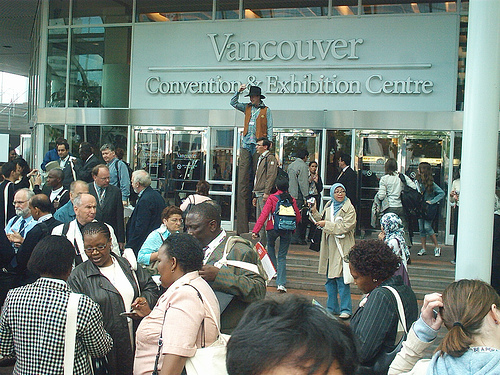 A thousand people are squished in and outside of Ballroom C of the Fairmont Waterfront Hotel. 15 minutes of polite negotiation through the crowd, yet I have barely weaved into the ballroom proper. UN-Habitat Award winner John Friedmann is delivering his special lecture as part of the first annual UN Human Settlements Lecture series:
A thousand people are squished in and outside of Ballroom C of the Fairmont Waterfront Hotel. 15 minutes of polite negotiation through the crowd, yet I have barely weaved into the ballroom proper. UN-Habitat Award winner John Friedmann is delivering his special lecture as part of the first annual UN Human Settlements Lecture series:
‘The Wealth of Cities: Towards an Assets-Based Development of Urbanizing Regions’.
In John Friedmann’s worldview, the traditional divying up of the four factors of production into land, labour, capital, and management (entrepreneurship plus technology), with the latter three being globally mobile, give way to seven assets of urbanizing regions, grounded locally in a region’s numerous neighbourhoods.
The city region’s seven assets:
1. Human Assets: these fulfill people’s basic human needs (shelter and good health) while also addressing quality of life needs like co-education. In the “final analysis, this is a state responsibility.”
2. Organized Civil Society: as an asset, it has self-organizing attributes and translates into social networks. Friedmann’s numerous examples include: church, synagogue and masjids with multi-generational congregations; cooking clubs throughout Spain; amateur sports teams across city regions; yet paramount are grassroots people becoming “active politically” who then “lobby civic governments.”
3. Heritage Assets: more complex than the catch-all word of ‘culture’, heritage as an asset is measured by the “spirit of the people and the vibrancy of a city’s cultural life.” Physical heritage (buildings and monuments) and heritage values preserve relics (murmur) and memory (t.ode) of a bygone era. Such continuity is important as Friedmann argues designated heritage districts (Old Cabbagetown) are very important. Afrofest, Pedestrian Sundays Kensington Market, Word on The Street are Toronto examples of “spontaneous appearances of creative annual events [and] are things to look forward to. [The] strength of a region are its people and traditions.”
4. Local Intellectual and Creative Assets: the Japanese name such individuals, “living human treasures”. Contradicting Richard Florida’s Creative Class thesis of cities competing for nomadic talent, Friedmann emphasizes, “creative work deserves creative support.” Consequently local people must have the “freedom to create”. This suggests support for creativity from ordinary people rather than extraordinary support for the already creative.
5. Natural and Physical Assets: forest and rivers and the fringe. “The Fringe is where village and city meet: airports and strip developments”. The cost of “fractured, fragmented and out of control development” in a “city’s relentless expansion undermine its own development.” Suburbs are in fact a ‘public space’ between rural and urban.
6. Environmental Assets: water, air, and high density living. “Draconian measures are needed, otherwise we drown in our own waste.”
7. Quality of Urban Infrastructure as an Asset: Friedmann asks, “what purpose and social groups are being served?” Is it the “15% emerging middle [automobile] class” or the needs of “the 80% bike, [public] transit, and walking [class]…city building can be a 15% or 80% solution.”
Being first to the second mic during the Q&A, I ask John Friedmann, “How does public space support your seven assets?”
“The first public space was the street. The state shouldn’t regulate the street other than order. [In] states where public space is absent, people use ’semi-public space’, a teahouse or a pub, wherever people are gathering together. Public space in contemporary China is the neighbourhood temple where congregations share belief. The question is one of regulation or absence of regulation. Public finance is necessary but savings is important. Cities around the world live hand to mouth with money from federal governments. You need urban savings to finance the city.”
In other words, Friedmann answers my question with a question: will the city be 15% full or 80% empty ?
HiMY SYeD
World Urban Forum 3, Vancouver


